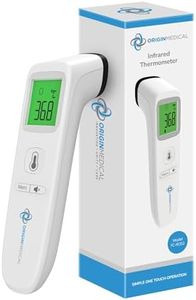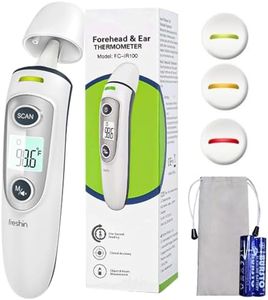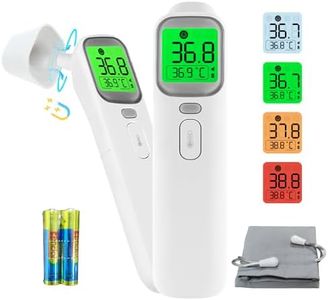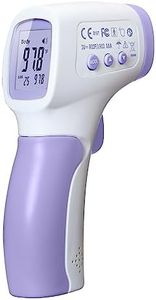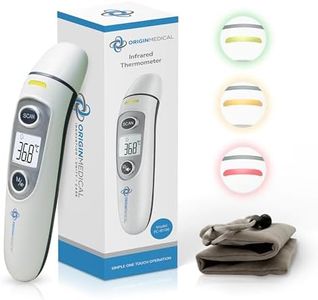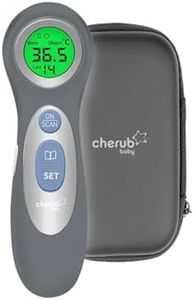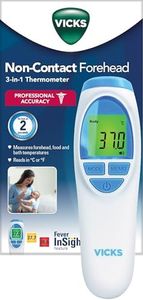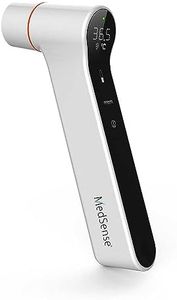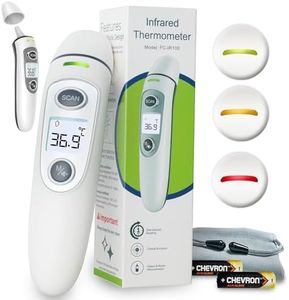We Use CookiesWe use cookies to enhance the security, performance,
functionality and for analytical and promotional activities. By continuing to browse this site you
are agreeing to our privacy policy
10 Best Forehead Thermometers
From leading brands and best sellers available on the web.Buying Guide for the Best Forehead Thermometers
Choosing a forehead thermometer can make a big difference in how easily and reliably you can monitor body temperature at home, especially for babies, young children, or the elderly. When shopping for a forehead thermometer, it's important to consider how easy it is to use, how accurate it is, and the specific needs of your household. Understanding the key features will help you pick a device that matches your expectations and use case.AccuracyAccuracy refers to how close the thermometer's measurements are to the actual body temperature. This is crucial for reliable health monitoring, as even small errors could affect decisions about seeking further care or medication. Forehead thermometers can have different degrees of accuracy, often measured in tenths of a degree. Some are designed for quick screenings and might be slightly less precise, while others aim for clinical-grade readings. If you need to monitor temperature for medical reasons, opt for higher accuracy models, even if they may take a little longer or need to be used in a more specific way.
Measurement TimeMeasurement time is how long it takes for the thermometer to give you a reading after you start measuring. Fast measurements (often 1-2 seconds) are convenient for squirmy children or busy settings, while slightly slower devices (up to 5 seconds) may offer higher accuracy. If you’ll be using the thermometer with young kids or in situations where quick results are important, shorter measurement times are helpful. However, if you prioritize accuracy and don’t mind waiting a few extra seconds, longer measurement times can be acceptable.
Contact vs. Non-ContactSome forehead thermometers require you to touch the device to the forehead, while others work without contact, simply aiming at the forehead from a short distance. Non-contact thermometers are more hygienic and reduce the risk of spreading germs, making them ideal for use on multiple people. Contact models might be slightly more accurate, as they don’t depend on your aiming skill or distance, but require cleaning to prevent contamination. Choose non-contact for frequent use across different individuals, especially during illness periods, and contact models when cross-contamination isn’t a concern or when absolute accuracy is a priority.
Ease of UseEase of use involves how simple the thermometer is to operate and read. Some models have clear displays, large buttons, and intuitive controls, while others might be more complicated. Features like backlit screens, audible cues, and color-coded results make it easier to use, especially in dim environments or at night. If you need a thermometer for elderly users, those with poor eyesight, or use in the dark, prioritize user-friendly designs and displays.
Memory FunctionMemory function allows the thermometer to store previous readings, which can be useful for tracking temperature changes over time. Some thermometers store only a few readings, while others can keep a longer log. If you are monitoring someone’s health for ongoing illness or need to share information with a caregiver or doctor, choosing a model with a good memory function can be very helpful. For occasional use, this feature may not be as critical.
Hygiene and CleaningHygiene and cleaning refer to how easy it is to keep the thermometer sanitary between uses. Some models have replaceable caps or covers, while others can be wiped clean with alcohol. Non-contact versions require less cleaning since they never touch the skin. Consider how often and for how many people you’ll use the thermometer; if it’s for a whole family, easy-to-clean and non-contact features become more important.
Power SourcePower source matters because it determines how you will keep your thermometer running. Most use standard batteries, like AAA or AA, while some might have rechargeable options. Frequent users should look for models with long battery life or easily available batteries. If you only plan to use it occasionally, this may be less of an issue, but always make sure you have extra batteries on hand for emergencies.
